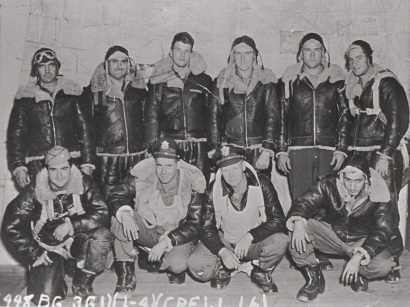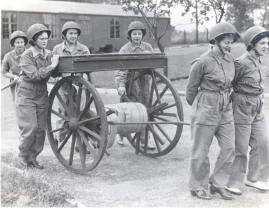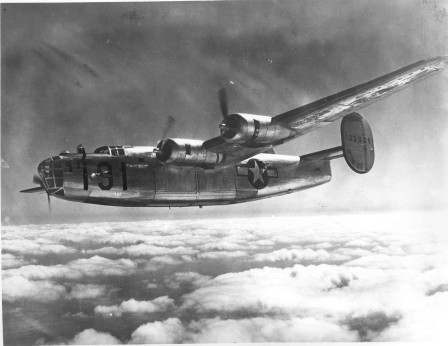During the Second World War, East Anglia became home to thousands of US airmen. The United States 8th Army Air Force (USAAF) arrived in Norfolk in 1942, and between 1942 and 1945 there were at any one time around 50,000 USAAF personnel stationed within a 30 mile radius of Norwich.
The impact of this “friendly invasion” on local communities was considerable, particularly in villages where American servicemen (and women) vastly outnumbered the local population. Initial suspicion and prejudice towards the GIs rapidly disappeared among those who got to know them. It was a time of jitterbugging dances and big band sounds, and the first taste of peanut butter, chewing gum and coke for many Norfolk people. Enduring friendships were forged between the Americans and the local population, which still endure today.
The Airfields
There were 18 USAAF airfields in Norfolk during World War Two, occupied by Bomb Groups flying B-17 Flying Fortresses or B-24 Liberator aircraft, and Fighter Groups providing support with their P-47 Thunderbolts, P-38 Lightnings and P-51 Mustangs. Traces of many airfields still exist today, and some are still operational (Horsham St Faith is now home to Norwich International Airport).
Attlebridge Airfield
Situated near Weston Longville, Attlebridge was home to the 466th Bomb Group from March 1944 to July 1945. Built in 1941 the airfield was originally a satellite base to Swanton Morley for RAF Bomber Command. The runways, perimeter track, and a few of the handstands remain as does the control tower, now extensively renovated and used as offices by Bernard Matthews Limited who own the airfield site. Memorials: There is a memorial at Frans Green; the village sign in Weston Longville is dedicated to the 466th BG; and there is a Roll of Honour in All Saints Church, Weston Longville.
Bodney Airfield
Located 4.5 miles west of Watton, Bodney opened in 1940 as a satellite to RAF Watton. In 1943 it became home to the 352nd Fighter Group (“The Blue Nosed Bastards of Bodney”). Now a British Army training area and agricultural land, a few wartime buildings and the control tower remain. Memorials: There is a memorial at the entrance of the army camp, on the B1108.
Deopham Green
Two miles north of Attleborough, Deopham Green was home to the 452nd Bomb Group from February 1944 to April 1945. Now an industrial estate and agricultural land, extensive remains of all three runways can still be seen. Memorials: A memorial is set beside a surviving piece of taxi-way;another in the churchyard of St Andrews Church in Hingham; anda memorial plaque at Attleborough railway station.
East Wretham
Six miles north east of Thetford, Wretham was home to the 359th Fighter Group. Now part of the British Army’s Stanford Practical Training Area (also known as STANTA) and agricultural land. Memorials: There is a memorial plaque in the churchyard at St Ethelbert’s Church, and another in Thetford town centre opposite the Bell Hotel.
Fersfield
Sixteen miles south west of Norwich, Fersfield is most notable as the operational airfield for Operation Aphrodite, a secret plan for using stripped down war weary bombers as explosive packed, radio controlled flying bombs. Pilots would take-off manually and then parachute to safety leaving the bomber under the radio control of another aircraft. One such mission resulted in a plane exploding over the village of Blythburgh in Suffolk, killing Lt. Joseph P Kennedy Jnr, brother of future President John F Kennedy. In January 1945, the Aphrodite concept was abandoned as being unfeasible.
Today the land has been returned to agricultural use. The perimeter track and runways still exist, and a number of wartime buildings remain on the former airfield, and in the wooded areas to the south.
Hardwick
Hardwick airfield lies just south of Topcroft village, 5 miles east of the A140, 12 miles south of Norwich. Originally planned for the RAF, it was home to the 310th Bomb Group from September to November 1942, followed by the 93rd Bomb Group (known as Ted’s Travelling Circus) who made it their base for the rest of the war until June 1945. Memorials: A memorial stands in a small plot on
one of the old barracks sites just off the lane from Hempnall which runs to the east of the airfield. The USAAF WWII 93rd Bomb Group Museum has been established in some of the remaining Nissen huts at Airfield Farm, open on the 3rd Sunday of each month 10am – 5pm (May to October). The museum is dedicated to the memory of those who served in the 93rd Bombardment Group (H) of the USAAF, known as The Travelling Circus, or Ted’s Travelling Circus.
Hethel
Now home to Lotus Cars, the former airfield at Hethel is situated seven miles south west of Norwich on the A11. The 320th Bomb Group arrived in 1942, followed in 1943 by the 389th Bomb Group (nicknamed the Sky Scorpions). Memorials: 389th BG memorial headstone and Roll of Honor at All Saint’s Church, Hethel; a plaque and stained glass window in Carleton Rode Church dedicated to 17 air crew killed in a mid-air collision in November 1944; and the 389th BG Memorial Exhibition and Museum located in the restored chapel at Potash farm, Potash Lane, Hethel, NR14 8EY, open on the 2nd Sunday of each month, 10am – 4pm (April to October).
Adjacent to the airfield is Ketteringham Hall, 2nd Air Division Headquarters from December 1943 – June 1945. Memorials: there is a memorial plaque in the hall grounds (now private property)
Whilst visiting All Saints Church – look out for “Hethel Old Thorn”, reputed to be over 700 years old, the oldest known living hawthorn tree in East Anglia.
Horsham St. Faith
Now home to Norwich International Airport, this former RAF Station was occupied by the 56th Fighter Group, and the 319th and 458th Bomb Groups. A number of wartime buildings remain, although converted to other uses. Memorials: memorial plaque and display in the airport terminal building; and stone memorial adjacent to the terminal building. North of the airfield is the City of Norwich Aviation Museum, with a collection of preserved aircraft and a display featuring the 458th BG, and a memorial on the grass verge at the museum entrance.
North Pickenham
Two miles south east of Swaffham, North Pickenham was initially home to the 492nd Bomb Group, and later the 491st Bomb Group (relocated following a massive explosion at Metfield airfield). Now partly an industrial area, with the remaining site returned to agriculture. Memorials: A memorial stone is situated at the entrance to the old mess site; a quartz clock in the parish church; and a memorial bench adjacent to the North Pickenham village sign. You can find out more about personal experiences of North Pickenham in interviews collected as part of ‘Swaffham: Within Living Memory’, an oral history project run by Swaffham Museum.
Old Buckenham
Two miles south east of Attleborough, the 453rd Bomb Group flew 259 missions from Old Buckenham between December 1943 and April 1945. Both James Stewart and Walter Matthau were based here. Memorials: A stone memorial on the southern side of the airfield; and the Old Buckenham Village Hall extension is a memorial for the Group containing a plaque, Roll of Honor and wartime memorabilia. The airfield is still in operational use, see http://oldbuck.com for information.
Oulton
USAAF Base – 803rd Radio Counter Measures Squadron. Now the RAF Oulton Museum in the grounds of Blickling Hall.
Rackheath
Five miles north east of Norwich, Rackheath airfield was home to the 467th Bomb Group (known as the Rackheath Aggies). The technical site has become Rackheath Industrial Estate, with several of the wartime buildings being modified or extended. The road leading to the restored Control Tower is named Witchcraft Way as a tribute to one of the most famous B-24 Liberator bombers flown by the 467th,
and Albert Shower Road commemorates the Group’s Commanding Officer. Memorials: A stone memorial at Wendover Road on the industrial estate; a memorial plaque and seat close to the village sign, adjacent to Holy Trinity Church.
Sculthorpe
In January 1944, 100 Group Royal Air Force No. 214 Squadron RAF moved to Sculthorpe airbase with the Boeing B-17 Fortress aircraft, and were joined by crews from the USAAF 96th and 803rd Bomb Groups. Some elements of the 803rd unit accompanied 214 Squadron when it transferred to Oulton on May 16th 1944, and the airbase at Sculthorpe – now empty – was redeveloped as a Very Heavy Bomber Base.
Sculthorpe was used by USAF during the Berlin Crisis of 1949. During the Cold War, the airbase was home to the 49th Air Division and the 47th Bombardment Wing.
Seething
Ten miles south east of Norwich, just to the east of Kirstead Green which is on the B1332 road to Bungay, Seething airfield was home to the 448th Bomb Group from November 1943 to July 1945. Most of the old airfield has reverted to farming, the eastern section is used by the Waveney Flying Group. Memorials: The Control Tower has been renovated and forms a memorial museum, open on the first Sunday each month (May to October); there is a memorial plaque nearby; a stone memorial outside the club house of the local flying club, and another in the village churchyard.
Shipdham
The first heavy bomber base in Norfolk, Shipdham was home to the 44th Bomb Group from November 1942 to June 1945. The airfield is now used by a local flying club. Memorials: A stone memorial opposite the south porch of All Saints Parish Church; a plaque on the side of the control tower; and a third memorial outside Shipdham Flying Club’s main entrance. A small museum is housed within the club’s facilities, open on the last Sunday of each month, 10am to 4pm, or by prior arrangement.
Snetterton Heath
Now a motor racing circuit, Snetterton was home to the 386th Bomb Group for a few days then 96th Bomb Group. Memorials: Quidenham Church contains a small stained glass window and plaque.
Thorpe Abbotts
Near Diss, 17 miles south of Norwichon the A140, Thorpe Abbotts airfield was originally a satellite station (with Eye) for nearby RAF Horham. It became home to “the Bloody Hundredth (100th Bomb Group) in June 1943. Most of the site is now returned to agricultural use. Memorials: The village church contains the US flag and unit citation; and the Control Tower has been restored to become the 100th BG Memorial Museum.
Tibenham
Situated approximately 7.5 miles from Diss, Tibenham airfield was home to the 445th Bomb Group from November 1943 until May 1945. James Stewart was stationed here for a time as the wartime Commander of the 703rd Bomb Squadron. It’s now home to Norfolk Gliding Club. Memorials: A stone memorial near the clubhouse; and the village church contains a memorial plaque and a number of hassocks embroidered in memory of the 445th BG.
Watton
The airfield is located approximately 9 miles south- west of East Dereham. Home to both the third Strategic Air Depot (one of four repair depots) and the 25th Bomb Group. The airfield is now partly an RAF Station and a HM Prison site. Memorials: There is a memorial to the 25th BG just inside the main gate of RAF Watton, and another in Griston churchyard.
Wendling
The former airfield at Wendling is situated between the villages of Beeston and Wendling about four miles north-west of East Dereham. Wendling was the most northerly 8th Air Force heavy bomber airfield. Planned originally for RAF bomber use, Wendling was home to the 392nd Bomb Group from August 1943 to June 1945. Memorials: A granite obelisk monument stands in a small plot just off the airfield on the road to Beeston.
East Anglian Airfields outside Norfolk
Bungay (Flixton) Suffolk
The airfield opened in 1942, originally as a satellite of the American base at Hardwick. It was home to the 446th Bomb Group from November 1943 until July 1945. Memorials: Wooden gates and a seat inside the porch at St Mary’s Church, Flixton; and a memorial stone in a small of garden of remembrance further up the road on the left, close to the HQ buildings, technical site and end of the main runway. The nearby Norfolk and Suffolk Aviation Museum is home to the 446th BG Museum, and memorial.
Cambridge
The Cambridge American Cemetery and Memorial is the only World War II American military cemetery in the United Kingdom: www.abmc.gov/cemeteries-memorials/europe/Cambridge
Duxford Cambridgeshire
The Imperial War Museum at Duxford was home to the 78th and 350th Fighter Groups during World War Two. Memorials: Memorial stone located a the main entrance; and the American Air Museum stands as a memorial to the 30,000 American airmen who gave their lives flying from UK bases during the Second World War.
Bircham Newton
It wasn’t just American airmen that were stationed in Norfolk during World War Two. RAF Bircham Newton, one of the most important Coastal Command stations on the East Coast, became the base for many visiting units during the War, including the Royal Canadian Air Force 407 and 415 Squadrons.
There are a number of Canadian airmen buried in the Commonwealth War Graves Commission plot in the cemetery at St. Mary’s Church, Bircham Newton, including a number of Canadians who were flying with RAF Squadrons.
http://www.roll-of-honour.com/Norfolk/GreatBirchamStMaryChurchyardCA.html
https://www.cwgc.org/find-a-cemetery/cemetery/2081579/
http://www.forces-war-records.co.uk/Unit-Info/3998
Please note that most former airfield sites are now private property, and permission must be obtained prior to visiting. Please contact the 2nd Air Division Memorial Library staff for advice and further information.
All images on this page are from the 2nd Air Division Memorial Library’s outstanding archive.




